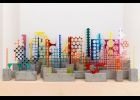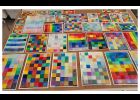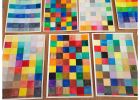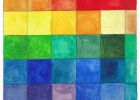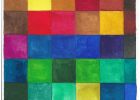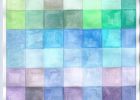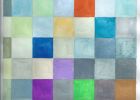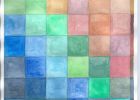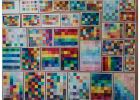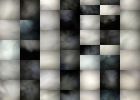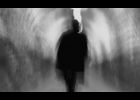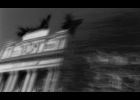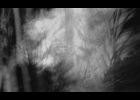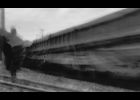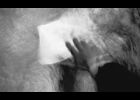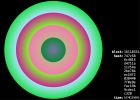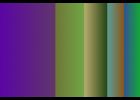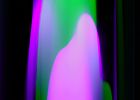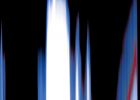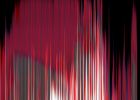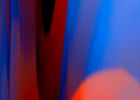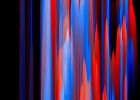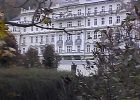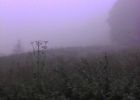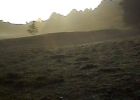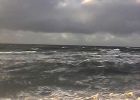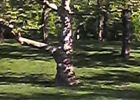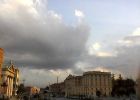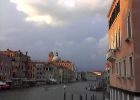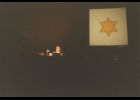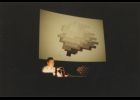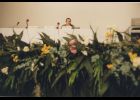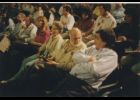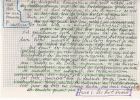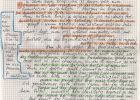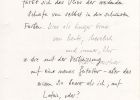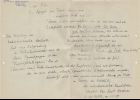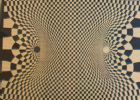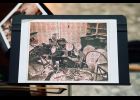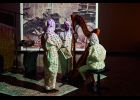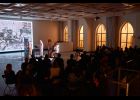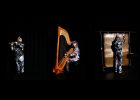Flusser Studies 35 – May 2023 / Special Issue: Vilém Flusser on Colour
Part I: On Colour
Schwarzweiß als Code / Black-and-White as a Code
Small Data Photography. Mit weniger Daten mehr erfahren
Everybody is snapshooting, everywhere. Flusser’s statement in his Toward a Philosophy of Photography from 1983 is even more significant forty years later in our brave new world of smartphone pictures. Is it possible to overcome the abundant redundancy of digital colour photography by using the same device, a mobile phone? In her experiments against the apparatus Vera Schwamborn developed what she calls „Small Data Photography“ as an answer. It is amazing that 480 x 640 pixel image on a small Nokia mobile can result in irritating and informative photographs opening a path to regain the world around us by small data. Flusser tried to combine aesthetics and technology as a way to bring back sensual experience into our abstract environment of calculus and computation. Together with Karl Gerstner he developed ideas of a colour code parallel to the all-embracing number codes of our time. Small Data photos also offer a reconciliation. They disclose a world of images that lie before the text and beyond the number.
Coloured technical images: On the Role of Colour in Vilém Flusser’s Work
Flusser wrote about colour from different points of view His interdisciplinary approach defies clear-cut borders by contaminating that which is generally thought to be separated. It rather seeks to create complex syntheses that play a privileged role in his texts on colour. In the same way, colours do not stick to the forms into which one tries to imprison them. They overflow, blend and bleed into each other. This essay focuses on four aspects of colour: the connection of black and white in photography and discourses on “racial” differences; the role of greyness and its relationship to colour luminosity in the description of culture and politics; the presence of colour in nature, landscape, and the animal world; Flusser’s use of colour in a redefinition of the notion of technical images in the context of the project of the Casa da Cor.
L’irruption du téchno-imaginaire / A. Bonnier Cor de Rosa / O negro será de cor? / Preto e branco / O preto é belo / Schwarz ist schön / Ecologia multicolorida? / Vom Umfärben der Grünen / Bunte Tiere / Disney Land Colors
This selection of texts, which date from the early 1970s to the late 1980s, documents Flusser’s interest in colour over nearly twenty years. Besides the connection of black and white in photography and discourses on “racial” differences, the role of greyness and its relationship to colour luminosity in the description of culture and politics, the presence of colour in nature, landscape, and the animal world, Flusser also used colour to redefine the notion of technical image.
Part II: Karl Gerstner, Philippe Henry, Gottfried Jäger and the Project of the Casa da Cor
Transparente Gegensätze – Logische Auflockerungen. Von den Abenteuern eines Bild-Ingenieurs und poetischen Konstruktivisten
Karl Gerstner’s work is above all about visibility (Sichtbarkeit) and conceivability (Denkbarkeit). It makes something unprecedented appear. In this context, colours play an essential role. Gerstner’s works are of great clarity and severity, they are inspired by a constant pursuit of abstraction punctuated with flashes of freedom. Both Vilém Flusser and Karl Gerstner were influenced by the thinking of Jean Gebser and his notion of a-perspectivity and transparency – diaphaneity in Gebser’s terminology.
Colourful Dialogue: Vilém Flusser, Karl Gerstner and the Casa da Cor
Casa da Cor connected Vilém Flusser with an important interlocutor: Karl Gerstner. Gerstner’s systems-based approach was laid out in his book Designing Programmes: Instead of Solutions for Problems, Programmes for Solutions (1964). He was involved in New Tendencies, the 1960s Zagreb-based group that saw research and the computer as a medium for artistic innovation, and he was included in landmark exhibitions like The Responsive Eye (1965) at the Museum of Modern Art in New York and documenta 4 (1968). Flusser and Gerstner discussed developing a denotative color code and creating a three-dimensional color space, called Colorarium, that would follow precedents like Kandinsky’s The Yellow Sound, composer Ivan Wyschengradsky’s audition colorée, or Le Corbusier’s Poème électronique (1958), as well as Gerstner’s earlier environments made with televisions, Plexiglass spheres, and acrylic-on-polyester reliefs. Neither the Colorarium nor the color code were realized, but they were theorized in Flusser’s writings: “On Science III” (1988) in Artforum mentioned Casa da Cor and asked, “Could a color code become a sort of universal Esperanto, complementing or even substituting for spoken and written language?”
Colorarium: The Exchange of Letters between Vilém Flusser, Karl Gerstner, Philippe Henry and Gottfried Jäger
This essay is about the relationship and collaboration between Vilém Flusser, Karl Gerstner, Philippe Henry, and Gottfried Jäger and the way this impacted the project of the House of Colour in São Paulo between 1987 and 1989. In this period, Flusser exchanged numerous letters and texts with his three correspondents, continuously re-elaborating and expanding his ideas about colour and their specific role in the project. This communication process was naturally enough multilingual. Flusser used English, German and Portuguese interspersed with French. Jäger wrote his texts in German, Gerstner in German and English, and Henry used Portuguese and French. The plurality of idioms is echoed in the use of different media. Besides forms of written communication (letters, essays, telegrams), video interviews were done in Robion, which were viewed and commented upon in Brazil. Henry conveyed the questions by phone and Flusser reacted in written form. Gerstner and Flusser wrote several texts together. Flusser travelled three times to Brazil, visited Gerstner in Basel and Hippoltskirch and Jäger in Bielefeld. Both Gerstner and Jäger came to see him in Robion. Henry travelled several times to Robion, and also met Gerstner and Jäger. All this ensured a constant flow of back-and-forth information within the small network of friends.
Letters / Farben statt Formen / Coloration replacing formalisation / Farben verschlüsseln / Karl Gerstner / Vilém Flusser und die Farben
Vilém Flusser and Karl Gerstner got to know each other in February 1987 at the 2nd Latin American Seminar on Alternatives for the teaching of the history of science and technology. Their letter exchange covers a period of about two years (1987-1989). Flusser and Gerstner were united by an intellectual and emotional friendship, read each other’s works, and dedicated a very personal text to one another: “Karl Gerstner” and “Vilém Flusser und die Farben” published in 1992 after Flusser‘s death. Flusser wrote two other texts “Farben verschlüsseln“ and “Farben statt Formen“, together with its English version „Coloration replacing formalisation“ in early 1988, as a discussion proposal for Gerstner. He dedicated “Farben verschlüsseln“ to Gerstner and sent the text with a letter, dated March 4, 1988. While Flusser wrote all his texts with a typewriter, Gerstner’s letters are practically all handwritten and in some cases in colour. To emphasize this difference the letters have been published separately and in different formats: Flusser’s letters are PDF-files and Gerstner’s JPEG and JPG-files.
Letters / Postmoderne Farben
Although Flusser met Gottfried Jäger in 1984, the dialogue between them began with a short letter from Flusser to Jäger on March 4, 1988, presenting the project of the Casa da Cor. The letter is accompanied by the essay „Postmoderne Farben” which Flusser dedicated to Jäger, possibly to lure him into a collaboration. Jäger held a speech on autonomous colour on the second day of the 1989 conference (August 23) in São Paulo.
Letters / From a Universe in Colors toward a Color Universe
The letter exchange between Vilém Flusser and Philippe Henry covers a period of about two-years, from July 1987 to November 1989 and deals mainly with the organization of the project of the House of Colour in São Paulo. Henry and his wife visited Flusser in Robion and met Edith and Vilém Flusser on several occasions in Brazil. The letters were accompanied by texts related to the project, both by Flusser and Henry, who considered Flusser a teacher and a source of inspiration. In “From a Universe in Colors toward a Color Universe”, Henry discusses different understandings of colour, from Newton’s prism to modern biology, and how our understanding of colour has shifted.
Sobre a Casa da Cor – Entrevista com Philippe Henry
In this interview, Philippe Henry talks about himself, his intellectual formation, his intense friendship with Vilém Flusser, Karl Gerstner, Louis Bec and Gottfried Jäger, but above all about the cultural and philosophical significance of colour and the project of the Casa da Cor. The most salient philosophical attribute of colour is what Henry calls the “spectral continuum”, a notion that was also central to Flusser’s and Karl Gerstner’s understanding of colour. Colours project a fluid borderless world. Henry discusses at length the importance of Gerstner’s and Goethe’s colour theory and their criticism of Newton. In early 1987, Henry got to know Flusser through a student of FAAP (Fundação Armando Alvares Penteado). He visited Flusser several times in Robion that with the time became a kind of second headquarter of the Casa da Cor. After the failure of the project in Brazil in late 1989, Flusser and some friends, among them Jean Digne, attempted to transfer it to France. Heny also speaks about the planned journal “Revista da Casa da Cor” for which Flusser had written a few texts. Unfortunately, both projects were not realized. He concludes the interview by referring to Flusser’s attempt to move beyond physics and physiology in order to develop a cultural colour code: “Therefore, behind a new Color Code, there should always be a Cultural Theory of Colors. That was the task of the Casa da Cor. And it still is.”
Um alfabeto de azuis e amarelos
In the interview “Um alfabeto de azuis e amarelos” (An alphabet of blues and yellows) published by the magazine “Superinteressante” in November 1988, Flusser discussed his theoretical position. The problem with spoken and written languages is that they are inadequate to describe the world, which could be described much better in mathematical terms. However, the problem with numbers is that they are separated from each other by intervals. Colours, on the other hand, tend to blend into each other.
Reflexões sobre “A Casa da Cor à construir em S. Paulo” / Casa da Cor, (reflexões complementares) / Mesa redonda / A cor no mundo pos-moderno / Codigo de cores / Video palestra / Casa da Cor, S. Paulo / In search of a colour code / Why the house of ...
In the two years (1987-1989) in which Flusser collaborated in the project of the Casa da Cor he wrote a series of texts, held conferences, and made several video interviews that have been transcribed. Flusser discussed the House of colour from two distinct but complementary and converging perspectives: the new house to be built and the necessity of a new colour code. In the mid-1980s, Flusser formulated the notion of an all-encompassing convergence of cultural and technical codes. In the context of the project of the House of Colour, he reformulated this vision including colour.
Part III: Open contributions
Provocar uma falha no aparelho: arte e contraideologia / Inducing a failure in the apparatus: art and counter-ideology
This paper discusses media art in which the interrupted functioning of devices and systems serve as metaphors. It focuses on short-circuits between the apparatus as a machine, as a system and the apparatus as an ideology. In this analysis, we approach the concepts of apparatus and ideology, failure, and counter-ideology in three on-line artworks exhibited on Verter Platform during the years 2020 and 2021: Ok/Cancel, by Elias Maroso; Inundação, by Fran Favero; Padrões Anômalos, by Cesar Baio. With Vilém Flusser's concept of apparatus in mind, we propose that there is a counter-ideological and counter-hegemonic dimension in valuing the inoperative and interrupted in a society that increasingly imposes a logic of efficiency, productivity and consumption. In an ideal functioning, the apparatus (the media, the system) must be as transparent as possible, transmitting in such a way as to allow the subject to concentrate on the information (as when we look at a photo and believe in it as if we were seeing the thing/event itself). If something interrupts this flow, such as noise, technical failure or accident), the subject's attention turns to the medium, the system itself.
“We shall be your favorite disappearing act!” / Clare Strand, Playing a Photograph
This essay discusses the intellectual foundation of the research group Thinking Tools at the Royal Academy of Antwerp. Established within the photography department at the Academy, the research group quickly decided to mainly support research into experimental photographic practices that radically question existing presuppositions. It starts from André Bazin's contention photography is the only way we can enjoy the absence of the human hand in the production of an image and goes on to explore how this theme of absence has become a guiding principle for the research group. The writings of Vilém Flusser on photography introduced us to the concept of the apparatus and to the photographer as an operator. These allow us to critically rethink the idea of photography as a simple instrument of image making. For a better understanding of the sovereignty of the camera we turned another thinker inspired by Flusser, the French photohistorian Michel Frizot. His definition of photography as the conjunction of an optical and a chemical system helped us to grasp in more concrete terms how photography radically differs from other existing art forms. Combining the theoretical positions of Flusser and Frizot gave us a robust framework for the 2021 publication Off Camera which set out to demonstrate how the concept of ‘the photographic’ expanded into the larger realm of the visual arts. The essay concludes with a discussion of two artists whose work could illuminate how this concept of ‘the photographic’ is at play in contemporary art.
Clare Strand’s “Playing a Photograph” is a telematic dialogue between a photograph and musical performers from the Royal Conservatoire (https://vimeo.com/773269239/c934f6a17a).
